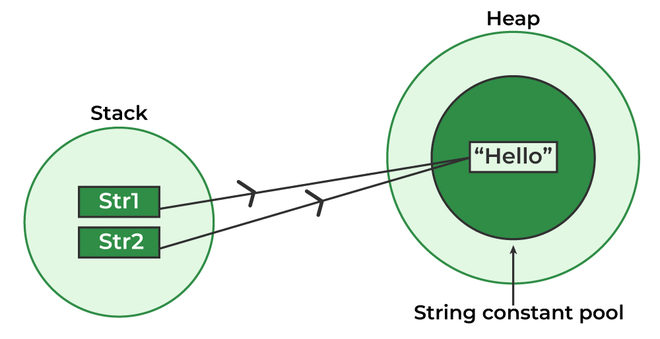Mastering Java Strings: String Pool, Immutability, and the Power of StringBuilder
 Nachiket
NachiketIntroduction
Welcome to another deep dive into essential Java concepts! This time, we'll uncover the inner workings of Strings in Java—how they are stored, what makes them efficient, and the game-changing role of StringBuilder. Understanding these fundamentals not only optimizes code performance but also prepares you to tackle coding problems with confidence.
1. Understanding the Java String Pool
When we create a String like String a = “Nachiket”; and then declare String b = “Nachiket”;, will both a and b point to the same object? The answer lies in the String Pool.
The String Pool is a special memory area in Java where unique string literals are stored. When a new string is declared, Java checks the String Pool:
If an identical string already exists, it points to the new reference (like
b) to that existing string, rather than creating a new one.If no identical string is found, it creates a new object in the pool.
This means a and b will reference the same “Nachiket” object, making your program more memory-efficient and optimized.

2. Immutability in Strings
Java Strings are immutable, meaning their values cannot change once created. If you try to alter a string, a new object is created instead. For example, if you have:
Immutability offers two main benefits:
Security: Once created, strings cannot be modified by other parts of the code.
Efficiency: The String Pool leverages this immutability for better memory usage.
3. Comparing Strings with == vs .equals()
When a and b reference the same object in the pool, a == b will return true. But if you create strings using new, like String a = new String("Nachiket"), they are stored as distinct objects, so a == b will return false even if the content is identical.
In such cases, .equals() is the go-to method, as it compares content instead of reference, providing an accurate comparison:
String a = new String("Nachiket");
String b = new String("Nachiket");
System.out.println(a.equals(b)); // true
System.out.println(a == b); // false
4. How toString() Impacts Output
When printing objects, Java automatically calls the .toString() method. For arrays, using Arrays.toString(array) provides a formatted view of the contents rather than the array’s memory address. You can check out the internal workings of Arrays.toString() in the code snippet provided.
public static String toString(char[] a) {
if (a == null)
return "null";
int iMax = a.length - 1;
if (iMax == -1)
return "[]";
StringBuilder b = new StringBuilder();
b.append('[');
for (int i = 0; ; i++) {
b.append(a[i]);
if (i == iMax)
return b.append(']').toString();
b.append(", ");
}
}
5. Introducing StringBuilder: The Mutable Alternative
Unlike Strings, StringBuilder is mutable. It modifies the existing object rather than creating a new one each time, making it faster and more memory-efficient for operations like appending or modifying content.
For example:
StringBuilder sb = new StringBuilder("Hello");
sb.append(", World!");
System.out.println(sb); // Output: Hello, World!
Since StringBuilder updates the original object, it is ideal for cases requiring frequent modifications.
Conclusion
Understanding the mechanics of Java Strings and StringBuilder is crucial for writing optimized code. The String Pool and immutability make Strings efficient, while StringBuilder adds flexibility and speed. Master these concepts, and you'll be well-prepared to tackle string operations effectively in Java.
Subscribe to my newsletter
Read articles from Nachiket directly inside your inbox. Subscribe to the newsletter, and don't miss out.
Written by
